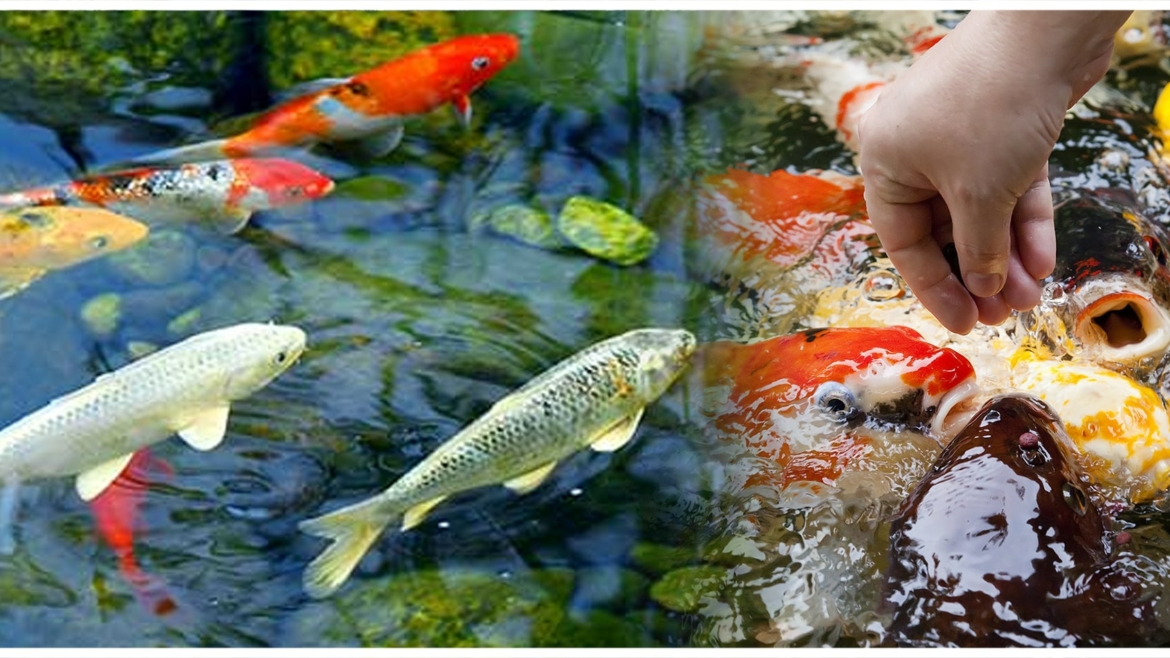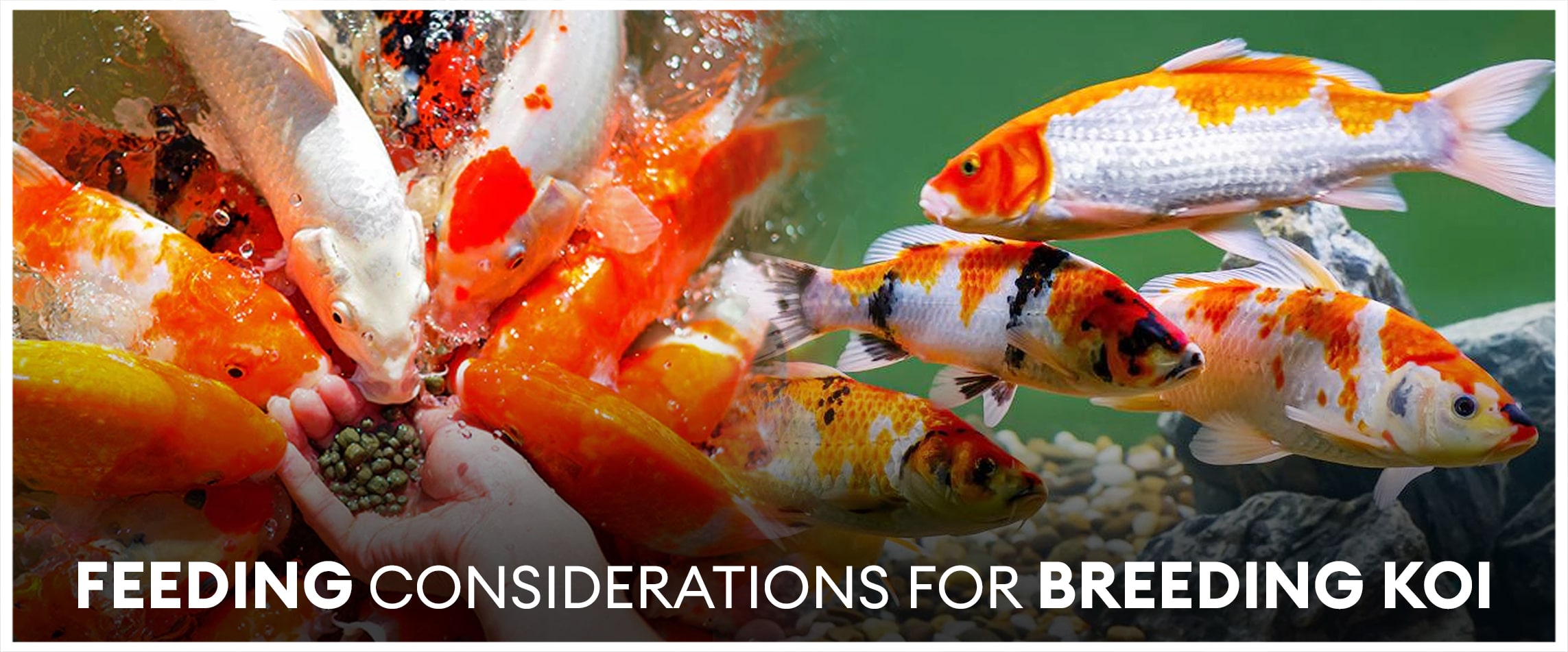Koi fishes are brilliant and light. People popularly know them to be in their ponds and water gardens. Another essential thing for every fish keeper to learn is a good feeding environment for koi fish, especially those who just started or are mad in love with it.
It will go a long way in enhancing their health and ensuring they grow well. This blog will focus on the essential aspects of feeding the koi fish. We will answer such questions as “Koi fish are friendly.” and “Feeding koi fish.”
Feeding Considerations for Breeding Koi
The importance of adjusting the feeding schedule is even more pronounced in case your koi are part of a breeding pair or if you plan to breed them. In the case of carrying pregnant eggs, including females, a different genetic diet will be needed to supplement the protein requirements necessary for reproduction and energy demands.
To preserve the eggs and fry from predatory intrusions, a separate breeding pond or section within the main pond should be provided where these individuals obtain adequate protection and nourishment.
Are Koi Fish Friendly?
People love koi fish as they are sociable. Koi fish can eat their food even when the pond is surrounded by lots of people who are feeding the fish. These charming fish are good friends; most get attached to their owners and become close friends.
Feeding koi fish by hand is quite pleasurable for people who own koi fish as a pet, and thus, they can feel much closer to their pets. The feeding of the koi fish can be made attractive, which will make the koi fish much healthier and happier.
Can You Overfeed Koi?
The Koi fish are eaters, but the overfeeding can make them unhealthy. This extreme feeding of koi fish will make them overweight, and that can cause them to develop diseases and have a short lifespan. A balanced diet can improve the well-being of the fish.
The amount of food you can offer your koi fish is one way of knowing how much they want to eat; for instance, provide them with what they can eat in five minutes. Regular observation of their bodies gives them optimal physical body shape.
How Often Should Koi Fish Be Fed?
The feeding frequency of the koi fish depends on the fish’s size, the water’s temperature, and the type of food you give them. They are active during the summer seasons, which are warm for koi fish. Giving them food twice a day every day is recommended.
In the winter season, the movement of their bodies slows down, so it is better to decrease the number of feeds per day to one time or every other day. Manipulating the feeding regimen into seasonal intervals boosts the health level of your koi fish.
Koi Feeding Temperature:
It is necessary to understand the temperature limits of the water and how the temperature may influence the amount of Koi fish required for one feeding. It has been established that koi fish digest their food more effectively in warm water; hence, the requirements for their feeding increase during summer.
Conversely, when it is cold, their body requires little or no energy; therefore, overeating can give them stomach problems. It is the method by which koi food can be changed based on the water that the koi fish are being kept in to ensure that they get the right supplements throughout all seasons of the year.
Koi Fry Food:
The rearing of koi fry takes specifics, especially regarding nutritional requirements. Young Koi must have high-quality fried food that enhances proteins and has vital nutritional benefits that justify their rapid growth and development.
They are fed every few hours, sometimes more than once a day, to provide the growing animals with a meal. On the other hand, as they grow, they slowly switch to bigger pellet sizes that should provide an easy transition to regular koi food.
Best Food for Koi Growth:
When it comes to nutrition for a koi, development and growth must be considered. The best-rated diet is balanced, which should contain proteins, fats, vitamins, and minerals to produce vibrant colors, robust immune systems, and vigorous growth.
A wide variety of high-quality koi chow is readily available in the market and formulated for optimum nutrition. The koi pellets relieve the koi keepers of the trouble of providing nutritional food for their precious kois without compromising their nutritional intake.
Enhancing the Feeding Experience:
Above the nutritional, happy feeding ensures a great deal of your koi’s overall well-being. One possible way to implement a feeding ritual is by establishing a designated feeding area and selecting a unique, deliberate movement associated with hand-feeding.
It allows your Koi to associate the site and your presence with sustenance, establishing a sense of protection and expectation while feeding them. It is interesting to see how koi learns and responds even to the owner’s voice a few days after being introduced.
Monitoring Koi Behavior:
Observing the behavior of your koi fish during feeding helps give you information about their health. Active and enthusiastic feeding is usually associated with good health, which means your koi are ready to eat.
On the other hand, a drastic loss of appetite or listless behavior may indicate an unseen health condition. By continuously observing during feedings, you can detect specific problems and address them as soon as possible, which may involve calling a vet if necessary.
Variety in Koi Diet:
While an excellent pellet shapes the groundwork of a koi’s eating routine, presenting assortment can upgrade their general sustenance. Enhancing their eating regimen with intermittent deals with live or frozen food sources, for example, saline solution shrimp, daphnia, or bloodworms, adds variety to their feasts. It takes exceptional care of their impulses and gives fundamental supplements that might be deficient in standard pellets.
Seasonal Considerations:
As the seasons change, so should your approach to koi feeding. However, during colder seasons when the pond could freeze over, ensuring such adjustments in feeding habits is essential. During low temperatures, koi hibernate and exhibit dormancy; in other words, they spend much time sleeping and lower their normal metabolism.
Feeding them too much during this period can lead to undigested food, potentially causing health issues. Utilizing specialized cold-water koi food with lower protein content helps accommodate their altered metabolic needs during winter.
The Role of Water Quality:
The quality of your koi water environment is directly responsible for their health. Their appetite and digestion may be affected adversely by such poor water quality, so they are likely to fall ill.
A comprehensive koi care routine includes regular testing, filtration device maintenance, and adequate aeration. Clear, fresh water assures their well-being and makes it possible for their spectacular colors to stand out from the pond environment.
Gradual Changes in Diet:
As your koi grow and mature, their dietary needs evolve. A one-size-fits-all approach may not suit koi of different ages and sizes. Adjusting the size and composition of their food as they grow ensures they receive the appropriate nutrients for their developmental stage.
Consult with reputable koi experts or veterinarians to determine the best feeding practices based on the specific requirements of your koi population.
Enrichment Activities:
Beyond the physical nourishment, incorporating enrichment activities during feeding can contribute to your koi’s mental stimulation and overall happiness. Consider using floating feeding rings or scattered feeding techniques.
These methods mimic the natural foraging behaviors of koi, encouraging them to explore their environment and promoting mental engagement. Additionally, introducing objects like floating logs or tunnels can create a playful atmosphere during feeding times, enhancing your koi’s overall quality of life.
Social Dynamics:
Koi are inherently social creatures, often displaying hierarchical behaviors within a group. Pay attention to the social dynamics during feeding sessions. Dominant individuals might assert themselves, while more submissive koi may wait for their turn.
If you notice any signs of aggression or bullying during feeding, consider redistributing the feeding area or providing multiple feeding spots to reduce competition and ensure all koi have access to their fair share of food.
Overcoming Common Challenges:
Koi keeping may present challenges such as unappetizing weather conditions, sudden water quality changes, or pests. During adverse weather, like heavy rain or extreme heat, monitor your koi closely and adjust feeding accordingly. Implementing preventive measures such as mosquito nets or screens can protect your koi from potential diseases carried by insects.
DIY Koi Treats:
Adding a personal touch to your koi’s diet can be rewarding and enjoyable for your fish. Experimenting with homemade treats using ingredients like fruits, vegetables, or even specially prepared gel-based foods adds a delightful variety to their diet. However, ensure that any homemade treats are free from harmful additives, preservatives, or seasonings that may harm your koi’s health.
Educating Fellow Koi Enthusiasts:
Sharing your experiences and knowledge with fellow koi enthusiasts is a beautiful way to contribute to the community. Participate in local koi clubs, online forums, or social media groups to exchange tips, insights, and success stories. By fostering a supportive network, you enhance your understanding of koi care and contribute to the collective knowledge base of the koi-keeping community.
Future Trends in Koi Nutrition:
Stay informed about emerging trends in koi nutrition. As technology and research progress, new and innovative feeds may become available, tailored to specific koi breeds or conditions. Keeping abreast of these developments ensures your koi benefit from the latest nutritional science, promoting their health, growth, and coloration.
Frequently Asked Questions:
Are koi fish friendly, and can they recognize their owners?
Indeed, koi fish are known for their amicable nature and ability to perceive their proprietors. Many people who love koi find that, given enough time and positive interactions, their fish become quite approachable, frequently swimming to the water’s surface in anticipation of feeding and even allowing gentle petting.
How often should I feed my koi fish, and can I overfeed them?
The feeding frequency depends on factors like water temperature and the size of your koi. In the warmer months, twice a day is recommended for feeding, while once or even every other day is sufficient in the colder months. Providing food that your koi can consume within five minutes is essential because overfeeding can cause health problems.
What’s the best food for koi growth, and should I include variety in their diet?
A well-balanced diet, usually in the form of high-quality koi pellets, is essential for optimal growth. However, incorporating variety can enhance their nutrition.
Occasional treats like live or frozen foods add diversity to their meals, ensuring they receive a broad spectrum of nutrients. Just remember to maintain a balance and not overindulge them with treats.
How can I create a more interactive feeding experience for my koi?
To make feeding time more engaging, consider establishing a feeding ritual. Choose a consistent spot for feeding, use a distinctive feeding gesture, and introduce floating rings or scattered feeding techniques to encourage natural foraging behaviors.
These activities contribute to their mental stimulation and strengthen the bond between you and your koi.
Final Thoughts:
Establishing a supporting responsibility for koi’s climate stretches out past just giving food. By integrating a comprehensive methodology that considers conducting perspectives, occasional varieties, water quality, and dietary variety, you can lift the prosperity and liveliness of your koi.
Remember that no two koi are alike, so taking good care of them and following a well-planned feeding schedule is essential for creating a healthy and harmonious aquatic ecosystem. The captivating world of koi keeping will unfold as you begin this journey, providing endless instances of enjoyment, education, and a deep connection with these magnificent aquatic companions.







